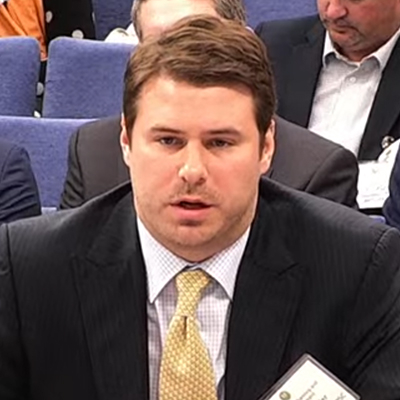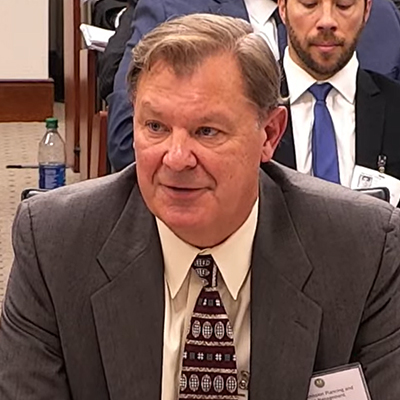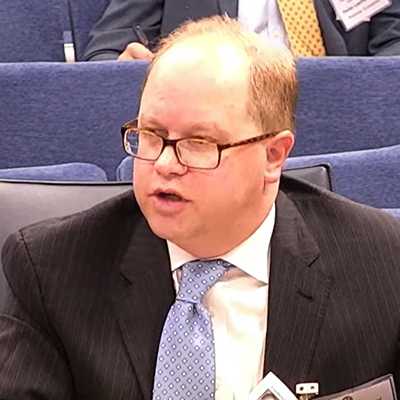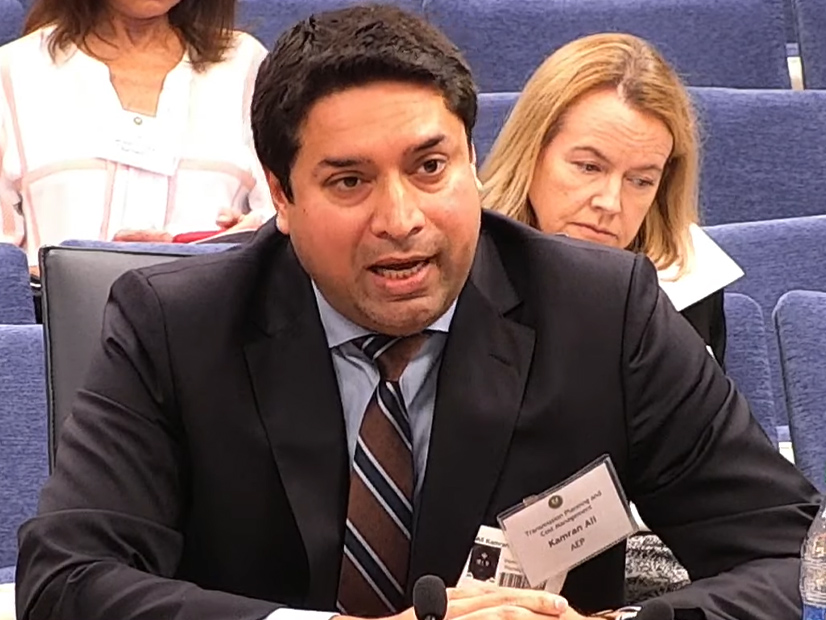Transmission owners found themselves on the defensive throughout Thursday’s FERC technical conference on transmission planning and cost management, as panelists decried the rising spending on end-of-life and other local projects that do not face any prudency reviews.
Kamran Ali, vice president of transmission planning and analysis at American Electric Power (NYSE:AEP), pushed back against the criticism, saying PJM’s Attachment M-3 process, which governs planning of supplemental projects — those not needed for system reliability or public policy compliance — is “the gold standard” for transparency.
 Lisa McAlister, American Municipal Power | FERC
Lisa McAlister, American Municipal Power | FERC“I can say that because I manage the transmission planning for AEP in four different RTOs,” Ali said. “I think it would be beneficial if people were to bring actual factual examples to the table: ‘In the M-3 process, here are the regional projects that would have displaced local projects, or here are the local investments that were not prudent, that were not rationalized that somehow made it through.’ If we have some of those real examples, I think we can enhance the M-3 process. Without examples I think it’s very difficult to make any improvements.”
PJM evaluates supplemental projects only to make sure they do not harm reliability. Municipal stakeholders have long complained about the lack of transparency surrounding their costs. (See PJM TOs Sign off on Supplemental Project Deal.)
Lisa McAlister, general counsel for regulatory affairs for American Municipal Power, responded that the reason that there are no examples is “because we simply don’t have enough information to identify” any. She said AEP does “a better job” than other PJM TOs in providing information, but “what we don’t have is how those replacements are prioritized; we don’t know [how] replacement versus maintenance decisions [are made]; how assets rank compared to other assets on the system.”
‘Appearance of Transparency’
“AEP has done a very good job in the M-3 process of responding to a limited number of suggestions,” agreed Kentucky Public Service Commission Chair Kent Chandler. “I have a certain number of questions, and [there] are now stock answers that they’re ready to provide people. … The reality is that although I understand what their criteria is … I have no idea what weight they’re giving” to them.
 Kentucky Public Service Commission Chair Kent Chandler | FERC
Kentucky Public Service Commission Chair Kent Chandler | FERC“The M-3 process gives us far more insight into local planning than the non-RTO utilities that we have, and even the MISO utility that we have,” Chandler added. “We understand through the M-3 process what their assumptions are and the criteria maybe, but there’s no way that we’re provided enough information to be able to replicate the decisions that are made by the utilities. So we understand that they may be looking at asset conditions, [but] we have no idea what kind of weight they’re giving them; whether they’re prioritizing certain conditions over others. It’s the appearance of transparency, and it’s enough to maybe placate some folks … but it is not enough to have an appreciation for how they’re actually doing local planning.”
But that’s still far more than what the PSC gets from its non-RTO utilities, he said. “We don’t find out what their planning outputs are until they show up to the commission for a certificate of public convenience and necessity, or it’s a fairly small transmission project and we don’t see until they file a rate case and it shows up in their forecasted test period. … We have no insight into their local planning.”
McAlister said RTOs should do more rigorous analyses of local planning criteria and proposed projects. But “to really have a meaningful opportunity to have a back-and-forth, you need more than the ability to submit comments,” she said. “There has to be some kind of actual requirement that the transmission owners respond.”
 Greg Poulos, Consumer Advocates of PJM States (CAPS) | FERC
Greg Poulos, Consumer Advocates of PJM States (CAPS) | FERCShe said PJM created a website for members to submit questions, but the RTO usually just says, “we’re working with the transmission owners; we’ll get back to you.” She said mirroring the M-3 process in other regions, “just having an arbitrary set of meetings and days to comment, we don’t think is something that gets us there.”
Greg Poulos, executive director of the Consumer Advocates of PJM States (CAPS), said in-house experts can only do so much.
“We have the money to hire an expert. I just don’t know what our expert would do with only 10 days to review projects, no ability to ask the questions and no expectation that they’re going to respond to us,” he said.
“Those are things you would hear from … an independent transmission monitor: ‘Those are flaws in this process. There’s a significant gap here [and] PJM, you need to do something about that.’ It’s different from me saying that, because I’m not getting response to that.”
PJM Cites Difficulty Identifying Regional Projects
Kenneth Seiler, PJM’s vice president of planning, said the RTO has not pursued more regional projects because the RTO is not seeing high load growth except in some areas such as Northern Virginia, which has experienced an explosion of data center load. (See PJM Sees Additional $603M ‘Data Center Alley’ Tx Spend.)
 Kenneth Seiler, PJM | FERC
Kenneth Seiler, PJM | FERC“We look for opportunities for regional transmission, but in many cases, it’s not the most cost-effective solution,” Seiler said. “We have had occasions in the past, though, where we had identified regional solutions [and] we could not get the line sited. The one example I can think of off the top of my head was about a $100 million regional transmission facility … The [state] commission wouldn’t site it within that particular state. And we ended up spending over double — over $200 million for sub-transmission upgrades.”
Erik Heinle, of the D.C. Office of the People’s Counsel, said PJM’s expertise in engineering and power flow analysis is “world class.”
“But we see far too many instances where PJM is not acting as the regional planner and bringing regional projects to the region,” he said.
Existing Cost Containment Practices
FERC Commissioner Willie Phillips expressed interest in MISO’s variance analysis, in which the RTO reevaluates projects facing lengthy schedule overruns or a 25% cost increase. MISO can either let projects continue, cancel them or assign them to different developers. Jeanna Furnish, MISO’s director of expansion planning, said the variance analysis could be applied in other regions to scrutinize projects.
 FERC Commissioner Willie Phillips | FERC
FERC Commissioner Willie Phillips | FERCSPP Executive Vice President of Regulatory Policy Paul Suskie said that, more than a decade ago, SPP’s first regionally funded 345-kV line turned out to be significantly more expensive than its original estimate, causing the RTO’s Regional State Committee to call for a review and develop methods to contain costs. Since then, Suskie said, SPP has been tracking project costs in an evolving process. He said projects that exceed 20% of their original costs are subject to restudy, suspension and even cancellation.
FERC Chair Richard Glick asked transmission owners how they currently reduce cost exposure for customers on large, regional transmission projects.
Carolyn Cowan Barbash, vice president of transmission development and policy for NV Energy, said her company tries to write projects’ technical specifications as clearly as possible and makes sure it attracts multiple bidders on solicitations.
Ameren Transmission Company (NYSE:AEE) President Shawn Schukar said his utility considers how large projects will impact future projects and vets contractors for past performance in addition to their cost estimates. He also said Ameren considers the quality of transmission components and how often they might need maintenance and replacement. He said he “took exception” to the perception that transmission owners aren’t currently motivated to keep costs in check.
‘Cooking the Books’
Attorney Lauren Azar, a former Wisconsin regulator, said FERC should create a process for challenging local planning criteria (LPC), saying “a few bad apples” in MISO have overly restrictive criteria for the generation interconnection process.
“Even before any new generation is added into the models, upgrades are already required, because of the LPCs. So in other words, the TOs are cooking the books so that those generators are required to pay for those upgrades, even before their proposed generation is added,” she said. “That’s not OK.”
Grid-enhancing Technologies
Panelists also weighed in on the role of grid-enhancing technologies as a way to cut costs.
PJM’s Seiler said the industry could benefit from a guide identifying where grid-enhancing technologies “would have the biggest bang for the buck.”
 Erik Heinle, D.C. Office of the People’s Counsel | FERC
Erik Heinle, D.C. Office of the People’s Counsel | FERC“There’s a lot of reluctance on behalf of our asset-owning utilities to apply grid-enhancing technologies, frankly, because of things like the reliability of the internet, security of [the technologies and creating an] additional avenue by which we could be attacked from a cybersecurity view.
“And these things have to be reliable. From a pure planning viewpoint, in my mind, there’s very few grid-enhancing technologies that can be relied upon on a day-in, day-out basis where I know I can count on having that extra transmission capability.
“Things like dynamic line ratings can be applied on the physical transmission line to squeeze out a few more megawatts from a pure system operations view. From a planning view, I can’t count on” them, he said.
Heinle disagreed, saying GETs should be part of regional planning. Distributed energy resources “served as a valuable planning tool in California a few weeks ago. And when you hear comments like, ‘Well, we can’t always count on this or that’ — those were similar comments that we heard about solar [and] wind, not too long ago. We found ways to incorporate them into the grid, and to use them in our planning for resource adequacy.”
Glick asked consumer advocates if grid planners give sufficient consideration to alternatives when local transmission projects are proposed.
CAPS’ Poulos said there is not: “The transmission owners in the [PJM] region say, ‘We have control of whether we’re going to do grid-enhancing technology. You have no input on this.’”


